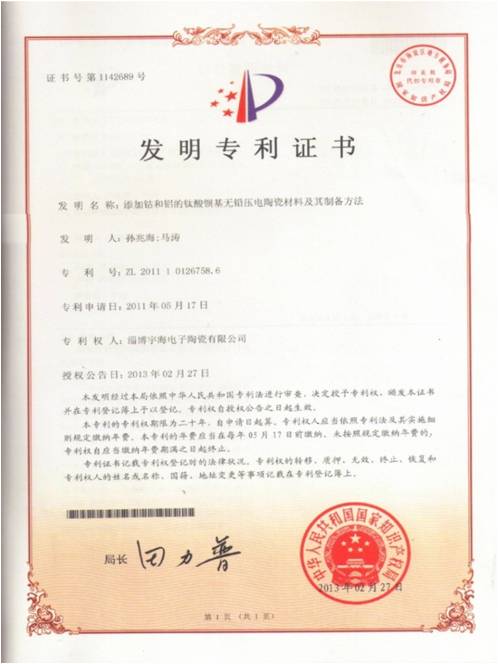







The Co-Al Co-doped Barium Titanate
Lead-free Piezoelectric Ceramics was successfully developed by Yuhai company
through repeated experiments. By Researching the influence of Co-Al Co-doping
on the structure and properties of Barium Titanate-based piezoelectric
ceramics, the formulation and preparation technology of Barium Titanate-based
piezoelectric ceramics were optimized. Yuhai`s BaTiO3 was prepared by conventional
solid-phase sintering method, with the piezoelectric constant d33 (>170pC/N),
dielectric loss tgδ≤0.5% and mechanical coupling coefficient Kp≥0.34.
Barium titanate lead-free piezoelectric
ceramics are important basic materials for the development of modern science
and technology, which was widely used in the manufacture of ultrasonic
transducers, underwater acoustic transducers, electroacoustic transducers,
ceramic filters, ceramic transformers, ceramic frequency discriminators, high
voltage generators, infrared detectors, surface acoustic wave devices,
electro-optic devices, ignition and detonation devices, and piezoelectric
gyroscope and so on.
Application: military, ocean, fishery, scientific research,
mine detection, daily life and other fields.
China Patent of Yuhai company`s BaTiO3
Chinese Patent No.: ZL 2011 1
0126758.6
Name: Lead-free Barium Titanate
Piezoelectric Material with Addition of Cobalt and Aluminum
Lead free piezo material BaTiO3
Lead-free Material
Properties
BaTiO3
Dielectric Constant
ɛTr3
1260
Coupling factor
KP
0.34
K31
0.196
K33
0.43
Kt
0.32
Piezoelectric coefficient
d31
10-12m/v
-60
d33
10-12m/v
160
g31
10-3vm/n
-5.4
g33
10-3vm/n
14.3
Frequency coefficients
Np
3180
N1
2280
N3
Nt
2675
Elastic compliance coefficient
Se11
10-12m2/n
8.4
Machanical quality factor
Qm
1200
Dielectric loss factor
Tg δ
%
0.5
Density
Ï
g/cm3
5.6
Curie Temperature
Tc
°C
115
Young's modulus
YE11
<109N/m3
119
Poison Ratio
0.33

Lead Free Piezoelectric Elements
Piezo Element,Piezo Ceramic Elements,Piezoelectric Ceramic,Pzt Tubes
Zibo Yuhai Electronic Ceramic Co., Ltd. , https://www.yhpiezo.com